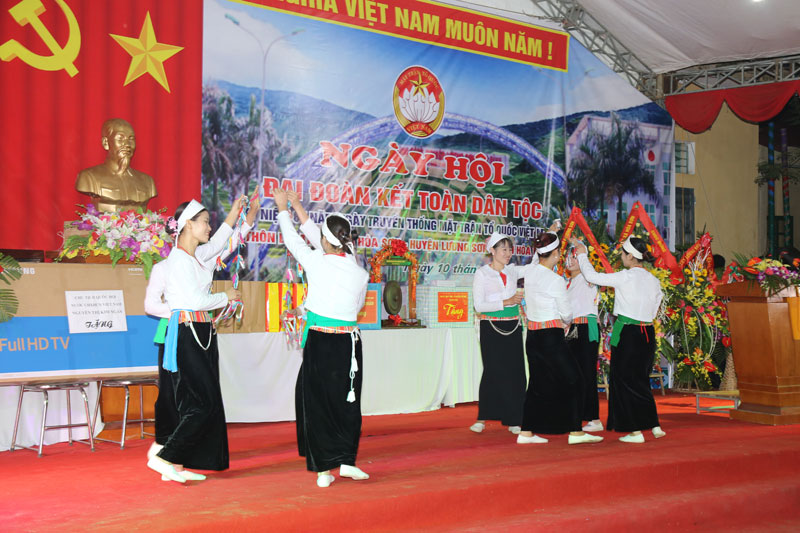
(HBO) With a total of 141 households, 699 people, the income of 77% households are mainly from raising stocks and planting, but up to now, the average income of people in Bui Tram village (Hoa Son commune, Luong Son) reached 30 million VND/ person/ year, the proportion of poor households declined to 2,1% according to new criteria.
The people in Bui Tram village, Hoa Son commune ( Luong Son) actively respond to the cultural and artistic movements to create a joyful and healthy life.
According to the assessment and classification in 2017, 90% households in the village met the cultural standard requirements and Bui Tram village has been continuously maintaining the title of Cultural Residence Area in 3 years (2015 – 2017). To get that achievement, in recent years, the Party, authorities and people in Bui Tram village have promoted the solidarity tradition, strengthened the movement of developing economy together and have had a lot of realistic activities to respond the campaign "All people unite to build a new and urban civilization”
The Head of Bui Tram village, Ms. Bui Thi Dung said: Thanks to the effective application of advanced scientific and technological achievements, new plants into farming, in the past years, the rice productivity in the village has reached at the average of 55 quintals/ hectare. Especially, since the movement of eliminating the mixed gardens, many households have developed the VAC models with high effectiveness like Mr. Quach Van Tham’s, Mr. Hoang Cong Nhat’s ones with the income from 300 -500 million VND/ year. These models are being expanded step by step. Besides, the trading business activities have got some good development such as Mr. Do Xuan Nhat’s family specializes in construction materials; Mr. Dinh Van Tuan and Quach Van Thanh’s families have high income from general business, etc.
Along with economy development, the Party, authority, organizations and agencies in Bui Tram village actively propagated, mobilized the people to implement well the Party’s guidelines and policies, the State’s policies and laws, the local regulations; to implement cultural lifestyle, civilized behaviors, to eliminate the obsolete customs, superstition, to preserve and promote the ethnic cultural identities, to actively participate in cultural, artistic, sports and physical training activities.
The Head of Women’s Union in Bui Tram village, Ms. Bui Thi Huyen said: The movements and activities of culture, art, sports and physical training have attracted many members, youth members and people to participate. This contributed to preserving and promoting the ethnic cultural identities in the residence. The residents are united to keep their lifestyles, fine customs and habits, and implement the civilized lifestyles in weddings and funerals. Over the past years, there has been no superstitious propaganda, superstitious practices, no third- childbirth and no case of child marriage. All the conflicts have been resolved right after arising; therefore, there are no overlapped complaint letters, crime or social evils.
Together with strengthening the movement of "All the people unite to build cultural lifestyle in the residence”, the learning promotion, talent promotion, building a community society have been actively participated by people of Bui Tram village. Since then, 100% of children at the learning age are able to attend schools; the percentage of graduates at all levels and the passing rate at colleges and universities has risen sharply compared to 2016. Participating in protecting environment, building clean and green landscapes are the activities that Bui Tram people actively join in. Up to now, 99% of the households have sanitary facilities, 100% of the households have access to clean water. All the manufacturing and trading firms obey the process of waste treatment. Public constructions, the village cemetery area have been completed according to the plan of building new rural area.
The People’s Committee of Lac Son district held a ceremony on April 28 to receive the provincial relic certificate for the ancient rock carving site at Suoi Co stream, located in My Thanh commune.
A special music show titled "The country is in the fullness of joy” has been held at Hoa Binh Square in Hoa Binh city in celebration of the 50th anniversary of the liberation of the South and national reunification (April 30, 1975–2025).
The People's Committee of Lo Son commune, Tan Lac district, has organised the local annual traditional stream fishing festival on April 19 - 20.
As a land deeply intertwined with human history and Vietnam’s millennia-long journey of nation-building and defence, Hoa Binh is often revered for its epic tales and legends.
Residents of Hoa Binh boast a rich cultural identity, reflected in their unique language, traditional attire, customs, and folk melodies – described as "sweet as honey, clear as a mountain stream.”
Lac Son district’s Vu ban town held the 2025 Truong Kha temple festival on April 12–13 (the 15th–16th days of the third lunar month). Since its revival in 2019, the festival has been organised every three years, preserving valuable intangible heritage while meeting the community’s cultural and spiritual needs.



